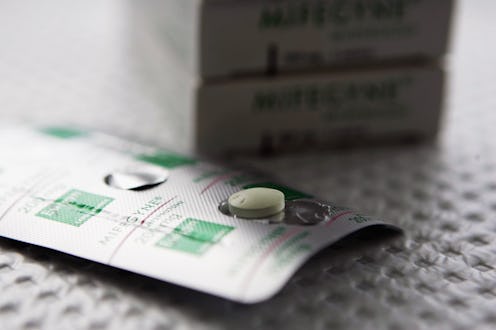News
The Abortion Pill Is Super-Safe, Science Says
For more than a decade, the majority of abortion providers in the United States have been administering the abortion pill with their evidence-based method: The first dosage is given to the patient at the clinic, while a second pill is taken in the privacy of a woman's home. But this method differs vastly from FDA-approved guidelines, which anti-abortion politicians have reinforced in recent years. So, which method works best? According to a new study, the evidence-based method for the abortion pill is just as safe as the outdated FDA guidelines, providing a new challenge to the laws banning the once-controversial method.
Although we still have a colloquial habit of saying "the abortion pill," abortion providers typically use two pills in the medical abortion process — 200 milligrams of mifepristone (also known as RU 486 and marketed in the U.S. as Mifeprex) taken at the clinic, followed by 800 micrograms misoprostol taken at home. While the FDA approved the use of misoprostol, a drug known for treating ulcers, back in 2000, the agency still has some pretty strict limitations: each pill dosage must be taken in the physical presence of a doctor and there must be a follow-up two weeks later, necessitating three trips to the clinic in all.
The FDA guidelines also shorten the time frame in which a woman can receive a medical abortion. With the three-clinic visit method, medical abortions are only available until the 49th day of pregnancy. Meanwhile, the at-home method allows the abortion pill to be taken until the 63rd day of gestation.
But abortion providers, facing patients who have to travel hundreds of miles for a safe abortion, found a way to cut down on the burdensome trips to the clinic. Why not have woman take the second pill at home?
So, here's why this study is a big deal: A growing number of states have been trying to instate back-door bans on medical abortions by limiting its use. One surefire way to do so is by passing legislation mandating that medical abortions are performed by the FDA-approved guidelines only. It's sneaky, but it gets the job done. North Dakota's only clinic, for instance, had to stop providing medical abortions completely because it could not comply with the state's new restriction.
Anti-abortion politicians have been fighting this evidence-based medical abortion method for years, but now, researchers say these abortion providers may be right. (Also, science!) Published this month in the journal Contraception, researchers concluded that "the evidence-based regimen for medical abortion is highly effective" with an overall success rate of 97.7 percent. In fact, the researchers found that the efficacy rate was even higher than the previous studies that tested the in-clinic method. So basically, what are you waiting for, FDA?
The researchers analyzed the cases of more than 13,000 women between April 1, 2006 and May 31, 2011. Out of those who completed follow-up, efficacy of the evidence-based method was 97.7 percent, with the highest success rate 98.8 percent between 29 and 42 days of gestation.
As expected, the termination success rate was a bit less later in the pregnancy, standing at 95.5 percent between 57 to 63 days. Yet even then, the researchers noted, "this evidence-based regimen was still more effective than rates reported in the FDA-approved regimen."
It's also significant that the success rate between at the very end of the 63-day time frame is still higher than the success rate of the FDA-approved method. The researchers explained:
[E]ven in the 57 to 63 day range this evidence-based regimen was still more effective than rates reported in the FDA- approved regimen, which sets the upper gestational age limit at 49 days. ... This study adds to the growing literature supporting provision of medical abortion using evidence- based regimens, and supports the conclusion that legislative efforts to restrict medical abortion to the FDA regimen are based on political goals to restrict abortion services, not efficacy or patient safety.
But now we know what abortion providers have understood for years — and maybe both state legislatures and the FDA will finally pay attention, too.
Images: Getty Images (3)
